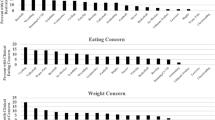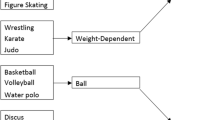Abstract
Purpose
The purpose of this present study was to examine gender differences in overall scores on the Eating Attitudes Test (EAT-26) in National Collegiate Athletic Association (NCAA) college athletes in “lean” sports versus “non-lean” sports.
Methods
Using a self-report survey design, this study examined eating disorder risk in 121 NCAA college athletes, using the EAT-26. We expected that female athletes and athletes in “lean” sports would report higher scores on the EAT-26.
Results
There was a significant effect of sport type (lean vs. non-lean) on eating attitudes and behaviors, with those in non-lean sports reporting higher scores, on average, on the attitudinal measure and those in lean sports reporting, on average, higher scores on the behavioral measure. There was an interaction between gender and sport type (lean vs. non-lean) on eating attitudes and behaviors. Male athletes in non-lean sports had the highest overall average scores on the attitudinal portion of the EAT-26, and males in lean sports had the lowest scores. However, on the EAT-26 behavioral portion, men in lean sports reported significantly higher scores than did men in non-lean sports. Female athletes, regardless of sport type, reported similar scores on both the EAT- 26 attitudinal and behavioral sections.
Conclusions
Our findings suggest that athletes, regardless of sport type and gender, may be affected by eating disorder symptomatology. Gender differences may be smaller in athletic populations than previously thought. Sport type may affect whether disordered eating symptomatology presents as attitudinal or behavioral in nature, especially in male athletes.
Level of evidence
Descriptive study, Level V.
Similar content being viewed by others
References
Patel D, Greydanus D, Pratt H, Phillips E (2003) Eating disorders in adolescent athletes. J Adolesc Res 18:280–296. https://doi.org/10.1177/0743558403018003006
Clifford T, Blyth C (2018) A pilot study comparing the prevalence of orthorexia nervosa in regular students and those in university sports teams. Eat Weight Disord. https://doi.org/10.1007/s40519-018-0584-0
Baum A (2006) Eating disorders in the male athlete. Sports Med 36:1–6. https://doi.org/10.2165/00007256-200636010-00001
Chatterton J, Petrie T (2013) Prevalence of disordered eating and pathogenic weight control behaviors among male collegiate athletes. Eat Disord 21:328–341. https://doi.org/10.1080/10640266.2013.797822
Kerr G, Berman E, Souza M (2006) Disordered eating in women’s gymnastics: perspectives of athletes, coaches, parents, and judges. J Appl Sport Psychol 18:28–43. https://doi.org/10.1080/10413200500471301
Voelker D, Petrie T, Reel J, Gould D (2017) Frequency and psychosocial correlates of eating disorder symptomatology in male figure skaters. J Appl Sport Psychol 29:1–8. https://doi.org/10.1080/10413200.2017.1325416
Arthur-Cameselle JN, Burgos J, Burke J, Cairo J, Colón M, Piña ME (2018) Factors that assist and hinder efforts towards recovery from eating disorders: a comparison of collegiate female athletes and non-athletes. Eat Disord 26:538–555. https://doi.org/10.1080/10640266.2018.1477673
Smolak L, Murnen S, Ruble A (2000). Female athletes and eating problems: a meta-analysis. Int J Eat Disord 27: 371–380. https://doi.org/10.1002/(SICI)1098-108X(200005)27:4%3C371::AID-EAT1%3E3.0.CO;2-Y
Bratland-Sanda S, Sundgot-Borgen J (2013) Eating disorders in athletes: overview of prevalence, risk factors and recommendations for prevention and treatment. Eur J Sport Sci 13:499–508. https://doi.org/10.1080/17461391.2012.740504
Goltz F, Schneider C, Stenzel L (2013) Disordered eating behaviors and body image in male athletes. Rev Bras Psiquiatr 35:237–242. https://doi.org/10.1590/1516-4446-2012-0840
Torstveit M, Rosenvinge J, Sundgot-Borgen J (2008) Prevalence of eating disorders and the predictive power of risk models in female elite athletes: a controlled study. Scand J Med Sci Sports 18:108–118. https://doi.org/10.1111/j.1600-0838.2007.00657.x
Rousselet M, Guérineau B, Paruit MC et al (2017) Disordered eating in French high-level athletes: association with type of sport, doping behavior, and psychological features. Eat Weight Disord 22(1):61–68. https://doi.org/10.1007/s40519-016-0342-0
Petrie T (1996) Differences between male and female college lean sport athletes, nonlean sport athletes, and non-athletes on behavioral and psychological indices of eating disorders. J Appl Sport Psychol 8:218–230. https://doi.org/10.1080/10413209608406478
Sanford-Martens T, Davidson M, Yakushko O, Martens M, Hinton P (2005) Clinical and subclinical eating disorders: an examination of collegiate athletes. J Appl Sport Psychol 17:79–86. https://doi.org/10.1080/10413200590907586
Chapman J, Woodman T (2016) Disordered eating in male athletes: a meta-analysis. J Sports Sci 34:101–109. https://doi.org/10.1080/02640414.2015.1040824
Voelker DK, Petrie TA, Huang Q, Chandran A (2019) Bodies in motion: an empirical evaluation of a program to support positive body image in female collegiate athletes. Body Image 28:149–158. https://doi.org/10.1016/j.bodyim.2019.01.008
Carter J, Rudd N (2005) Disordered eating assessment for college student-athletes. Women Sport Phys Activity J 14:62–71. https://doi.org/10.1123/wspaj.14.1.62
Hudson J, Hiripi E, Pope H, Kessler R (2007) The prevalence and correlates of eating disorders in the national comorbidity survey replication. Biol Psychiatry 61:348–358. https://doi.org/10.1016/j.biopsych.2006.03.040
Petrie T, Greenleaf C, Reel J, Carter J (2008) Prevalence of eating disorders and disordered eating behaviors among male collegiate athletes. Psychol Men Masc 9:267–277. https://doi.org/10.1037/a0013178
Sundgot-Borgen J, Torstveit M (2004) Prevalence of eating disorders in elite athletes is higher than in the general population. Clin J Sport Med 14:25–32. https://doi.org/10.1097/00042752-200401000-00005
Garner D, Olmsted M, Bohr Y, Garfinkel P (1982) The eating attitudes test: psychometric features and clinical correlates. Psychol Med 12:871–878
Kong P, Harris L (2015) The sporting body: body image and eating disorder symptomatology among female athletes from leanness focused and nonleanness focused sports. J Psychol 149:141–160. https://doi.org/10.1080/00223980.2013.846291
de Sousa Fortes L, Ferreira M, de França Costa P, da Silva Lira H, Andrade J, da Silva A (2015) Comparison of disordered eating between young athletes and non-athletes. J Bras Psiquiatr 64:296–302. https://doi.org/10.1590/0047-2085000000092
Picard C (1999) The level of competition as a factor for the development of eating disorders in female collegiate athletes. J Youth Adoles 28:583–594. https://doi.org/10.1023/A:1021606710398
Roberts T, Glen J, Kreipe R (2003) Disordered eating and menstrual dysfunction in adolescent female athletes participating in school-sponsored sports. Clin Pediatr 42:561–564. https://doi.org/10.1177/000992280304200613
Wadas G, DeBeliso M (2014) Disordered eating, eating attitudes, and reasons for exercise among male high school cross country runners. Sport J 1:1. http://thesportjournal.org/article/disordered-eating-eating-attitudes-and-reasons-for-exerciseamong-male-high-school-cross-country-runners/
Krentz E, Warschburger P (2013) A longitudinal investigation of sports-related risk factors for disordered eating in aesthetic sports. Scand J Med Sci Sports 23:303–310. https://doi.org/10.1111/j.1600-0838.2011.01380.x
Sansone R, Sawyer R (2005) Male athletes and eating disorders. Clin J Sport Med 15:45–46. https://doi.org/10.1097/01.jsm.0000157794.85381.c5
Pope Z, Gao Y, Bolter N, Pritchard M (2015) Validity and reliability of disordered eating assessment tools in athletes: a review. J Sport Health Sci 4:211–221. https://doi.org/10.1016/j.jshs.2014.05.001
Garfinkel P, Newman A (2001) The eating attitudes test: twenty-five years later. Eat Weight Disord 6:1–24. https://doi.org/10.1007/BF03339747
Viglione V, Muratori F, Maestro S, Brunori E, Picchi L (2006) Denial of symptoms and psychopathology in adolescent Anorexia Nervosa. Psychopathology 39:255–260. https://doi.org/10.1159/000094723
Starzomska M, Tadeusiewicz R (2016) Pitfalls in anorexia nervosa research: the risk of artifacts linked to denial of illness and methods of preventing them. Psychiatria Danubina 28:202–210
Karlson K, Becker C, Merkur A (2001) Prevalence of eating disordered behavior in collegiate lightweight women rowers and distance runners. Clin J Sport Med 11:32–37. https://doi.org/10.1097/00042752-200101000-00006
Defeciani L (2016) Eating disorders and body image concerns among male athletes. Clin Soc Work J 44:114–123. https://doi.org/10.1007/s10615-015-0567-9
Funding
There was no funding for this study.
Author information
Authors and Affiliations
Corresponding author
Ethics declarations
Ethical approval
All procedures performed in studies involving human participants were in accordance with the ethical standards of the institutional and/or national research committee and with the 1964 Helsinki declaration and its later amendments or comparable ethical standards.
Informed consent
Informed consent was obtained from all individual participants included in the study.
Conflict of interest
The authors declare that that they have no conflicts of interest.
Additional information
Publisher’s Note
Springer Nature remains neutral with regard to jurisdictional claims in published maps and institutional affiliations.
Rights and permissions
About this article
Cite this article
McDonald, A.H., Pritchard, M. & McGuire, M.K. Self-reported eating disorder risk in lean and non-lean NCAA Collegiate Athletes. Eat Weight Disord 25, 745–750 (2020). https://doi.org/10.1007/s40519-019-00681-0
Received:
Accepted:
Published:
Issue Date:
DOI: https://doi.org/10.1007/s40519-019-00681-0




